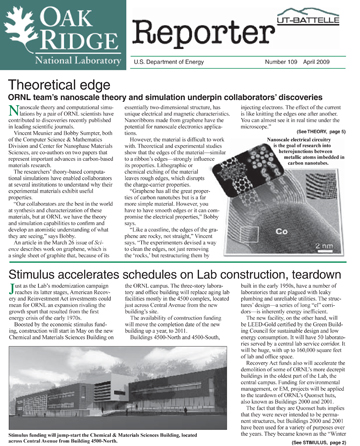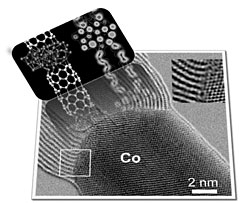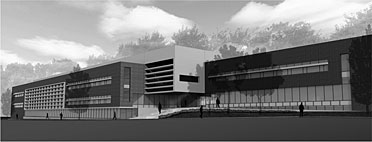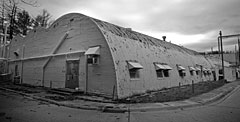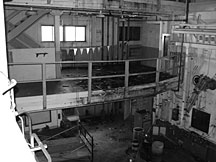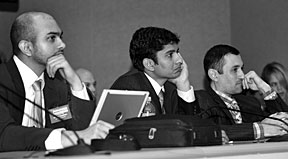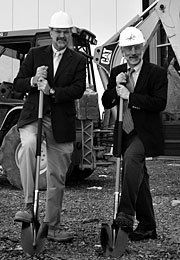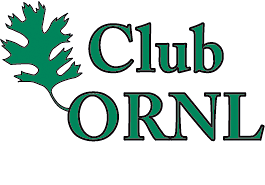 |
Number 109, April 2009 |
 Theoretical edge
Theoretical edge
ORNL team’s nanoscale theory and simulation underpin collaborators’ discoveries
|
|
Nanoscale electrical circuitry
is the goal of research into
heterojunctions between metallic atoms imbedded in carbon nanotubes. |
Nanoscale theory and computational simulations by a pair of ORNL scientists have contributed to discoveries recently published in leading scientific journals.
Vincent Meunier and Bobby Sumpter, both of the Computer Science & Mathematics Division and Center for Nanophase Materials Sciences, are co-authors on two papers that represent important advances in carbon-based materials research.
The researchers’ theory-based computational simulations have enabled collaborators at several institutions to understand why their experimental materials exhibit useful
properties.
“Our collaborators are the best in the world at synthesis and characterization of these materials, but at ORNL we have the theory and simulation capabilities to confirm and develop an atomistic understanding of what they are seeing,” says Bobby.
An article in the March 26 issue of Science describes work on graphene, which is a single sheet of graphite that, because of its essentially two-dimensional structure, has unique electrical and magnetic characteristics. Nanoribbons made from graphene have the potential for nanoscale electronics applications.
However, the material is difficult to work with. Theoretical and experimental studies show that the edges of the material—similar to a ribbon’s edges—strongly influence its properties. Lithographic or chemical etching of the material leaves rough edges, which disrupts the charge-carrier properties.
“Graphene has all the great properties of carbon nanotubes but is a far more simple material. However, you have to have smooth edges or it can compromise the electrical properties,” Bobby says.
“Like a coastline, the edges of the graphene are rocky, not straight,” Vincent says. “The experimenters devised a way to clean the edges, not just removing the ‘rocks,’ but restructuring them by injecting electrons. The effect of the current is like knitting the edges one after another. You can almost see it in real time under the microscope.”
|
Vincent Meunier (left) and Bobby Sumpter are demonstrating how theory and simulation improve the understanding of experimental work. |
Researchers at the Massachusetts Institute of Technology and the Laboratory for Nanoscience and Nanotechnology Research (LINAN) in Mexico used a method called Joule heating, in which a sample of graphene ribbon is suspended between a holder and a scanning-tunneling microscope tip. A current is then sent through the ribbon.
The resulting material displays sharp zig-zag and armchair-shaped edges as a result of the annealing process. Meunier and Sumpter’s computational simulations explained why the Joule heating had that effect on the materials—the carbon edges vaporize and then reconstruct at the higher, voltage-induced temperature, forming cleaner edges.
“There was no real explanation why it was working. Our simulations, with some quantum-based calculations, explained why it was happening that way,” Vincent says.
“Graphene is one of the hottest topics in the materials science literature. With this process, significant improvements can be obtained that open the door to graphene material for electronics and composite materials,” Bobby says.
The previous week, Proceedings of the National Academy of Sciences published another article with Sumpter and Meunier as co-authors. Their theoretical and simulation work, combined with experiments performed at the University of Strasbourg and LINAN, has contributed to a better understanding of how carbon nanotubes and metallic crystals can be used to build robust nanoscale
contacts.
Graphene is one of the hottest topics in the materials sciences. |
Researchers are interested in forming such contacts with carbon nanotubes and metal nanocrystals, since this is fundamental to the development of a multitude of electronic applications. Previously, in multiwalled carbon nanotube materials, the electrical connections between metallic crystals in the nanotube structures occurred only at the outermost wall. This rather feeble connectivity presented the technical barrier to fabricating a nanotube-metal composite material with suitable electrical properties.
“If you want to use nanowires in a device, you have to use them in the real, macroscopic world. At a nano level, these connections are pretty poor. This work shows an approach to connecting the nanoscale world to the ‘real,’ or macroscopic, world,” Vincent says.
Again, theoretical calculations and computational simulations by Vincent and Bobby revealed why a process of controlled electron irradiation results in heterojunctions with much stronger metal-to-metal interfaces.
“Our modeling enabled us to develop a complete understanding of the bonding at the interfaces seen by the experiments,” Bobby says.
The resulting “ultimate nanocontacts” appear very promising for making functional, nanotech-based electronic and ferromagnetic devices
.
Their collaborators on the graphene project (Science) were Xiaojing Jia, Mario Hoffman, Hyungbin Son, Ya-Ping Hsieh, Alfonso Reina, Jing Kong and Mildred Dresselhaus of MIT; and Jessica Campos-Delgado, Jose Manuel Romo-Herrera and Mauricio Terrones of Mexico’s LINAN.
The far-flung collaborators on the ultimate nanocontacts research (PNAS) are Julio Rodriguez-Manzo and Florian Banhart, Institut de Physique et Chimie des Materiaux in France; Mauricio Terrones and Humberto Terrones at LINAN, Mexico; Nicole Grobert at Oxford University, UK; Pulickel M. Ajayan at Rice University; and Mingsheng Wang, Yoshio Bando and Dmitri Golberg at Japan’s National Institute for Materials Science.
Vincent and Bobby performed the simulations on various resources available at ORNL’s National Center for Computational Science.—B.C. ![]()
 Stimulus accelerates schedules on Lab construction, teardown
Stimulus accelerates schedules on Lab construction, teardown
|
Stimulus funding will jump-start the Chemical & Materials Sciences Building, located across Central Avenue from Building 4500-North. |
Just as the Lab’s modernization campaign reaches its latter stages, American Recovery and Reinvestment Act investments could mean for ORNL an expansion rivaling the growth spurt that resulted from the first energy crisis of the early 1970s.
Boosted by the economic stimulus funding, construction will start in May on the new Chemical and Materials Sciences Building on the ORNL campus. The three-story laboratory and office building will replace aging lab facilities mostly in the 4500 complex, located just across Central Avenue from the new building’s site.
The availability of construction funding will move the completion date of the new building up a year, to 2011.
Buildings 4500-North and 4500-South, built in the early 1950s, have a number of laboratories that are plagued with leaky plumbing and unreliable utilities. The structures’ design—a series of long “el” corridors—is inherently energy inefficient.
The new facility, on the other hand, will be LEED-Gold certified by the Green Building Council for sustainable design and low energy consumption. It will have 50 laboratories served by a central lab service corridor. It will be huge, with up to 160,000 square feet of lab and office space.
Recovery Act funds also will accelerate the demolition of some of ORNL’s more decrepit buildings in the oldest part of the Lab, the central campus. Funding for environmental management, or EM, projects will be applied to the teardown of ORNL’s Quonset huts, also known as Buildings 2000 and 2001.
The fact that they are Quonset huts implies that they were never intended to be permanent structures, but Buildings 2000 and 2001 have been used for a variety of purposes over the years. They became known as the “Winter Palace” when the UT-Battelle contract transition team used them for offices in the winter of 1999-2000.
Land freed by the demolition of the structures will enable growth of the adjacent Oak Ridge Science & Technology Park fronting Bethel Valley Road. One building of the new S&T park, which is on land deeded by DOE to the Community Reuse Organization of East Tennessee, is already well along in
construction.
|
The builders of ORNL’s 1940s-era Quonset huts (above) probably thought they would be long gone by the twenty-first century. The interior of disused Building 3026 (below) has deteriorated significantly. |
“It just doesn’t make sense to have one of ORNL’s oldest and most dilapidated buildings only a block away from some of the world’s most modern research facilities,” Lab Director Thom Mason says.
EM funds may also be applied to the eventual disposition of Building 3026, the old Radioisotope Development Laboratory on Central Avenue, which has been closed since the 1980s.
ORNL science projects slated for stimulus funding support include the Fundamental Neutron Physics Beamline at the Spallation Neutron Source and facility upgrades at the Center for Nanophase Materials Sciences.
The Lab’s potential growth in science and technology programs, such as the Office of Science’s Energy Frontier Research Center program and Energy Efficiency and Renewable Energy projects, could mean adding 1,000 staff members over the next two years. The $277 million for the Energy Frontier Research Centers will be awarded to labs and universities on a competitive basis.
|
The economic stimulus legislation increases DOE’s budget by nearly $39 billion over the current funding base of $27 million. On the research end, one of the prime beneficiaries will be programs related to the energy sector.
In a meeting with ORNL managers, Thom noted that the new funding levels, not counting energy-related funding sent to states, eclipse the $28-billion-in-current-dollars price of the WWII Manhattan Project.
“Our intent is to develop sustainable, world-leading programs. We will be hiring where stimulus funds are jump-starting long-term programs. Attracting new staff is critical,” Thom says.—B.C., with Mike Bradley ![]()
 Zacharia, Roberto take new posts on
Leadership Team
Zacharia, Roberto take new posts on
Leadership Team
|
Zacharia |
In anticipation of American Recovery and Reinvestment Act program growth and other developments, several organizational changes have been announced by Lab Director Thom Mason.
Effective April 1, Thomas Zacharia became deputy director for Science and Technology and UT-Battelle senior vice-president for science and technology, responsible for coordinating ORNL’s major R&D programs.
“Thomas has done a remarkable job of building ORNL’s computational program into one of the world’s best. His new role will include leading our response to the opportunities made possible by the Omnibus and ARRA funding and ensuring that our strategy anticipates budget priorities in the years ahead,” Thom said.
|
Roberto |
Jim Roberto has assumed the new title of director of Strategic Capabilities. His new role entails developing the scientific and technical recruiting strategy needed to meet the anticipated growth in the Lab’s research activities. Jim will also be principal point of contact with the University of Tennessee. In preparation for an anticipated competition for the ORNL M&O contract, Jim will serve a dual role as UT-Battelle senior vice president for contract retention.
Jeff Nichols will serve as interim associate Laboratory director for Computing and Computational Sciences. ![]()
 Stairs named HR director
Stairs named HR director
|
Stairs |
Debbie Stairs has been named Human Resources Director. Previously manager of HR’s Organizational Training & Development group, Debbie will be responsible for identifying and recruiting new staff and will also oversee delivery of HR services to the more than 4,400 current ORNL staff members.
Debbie, a western Kentucky native, is a graduate of the University of Tennessee. ![]()
 |
 Gut collaboration blooms
Gut collaboration blooms
A while back, ORNL Reporter (Nov. 2007) described collaborations the Chemical Sciences Division’s Bob Hettich was exploring aimed at better understanding the role microbes play in the human gut and how that symbiosis affects human health.
ORNL’s contribution to this effort is its systems biology capabilities, particularly analytical mass spectrometry. Now a paper has been published based on one of these collaborations, with Jeffrey Gordon at Washington University and a number of co-authors, in Proceedings of the National Academy of Sciences.
Armed with seed money funding, Bob, along with ORNL staff member Nathan VerBerkmoes and graduate student Alison Russell, are collaborating with Gordon’s team to analyze the interactions of human microbes introduced into the digestive sykstems of gnotobiotic mice, which are mice whose gut microbiome has been eradicated.
Gordon rears these gut-sterile mice in carefully controlled, sealed chambers. He has developed a technique for introducing single species of microbes at a time into the mice; then slowly expanding the complexity of the population and studying the effects on the host and the microbes.
Gordon came to ORNL for mass-spectrometry-based proteomics. “We have unique expertise in determining protein signatures in microbial communities, which reveal a significant level of detail about how the microbes are functioning,” Bob says.
“What we’re finding is that there is an elaborate molecular signaling between the host and the microbes as the microbes compete and cooperate with each other to avoid the host immune system and otherwise adapt in this ecosystem. This entire process is very poorly understood.”
Mice and humans share many of the same bacteria. These studies could eventually help explain how the greater than 800 species of microbes in our bellies affect who we are and how we feel.
 Karsner to GVC: Green is key
Karsner to GVC: Green is key
|
Global Venture Challenge participants take in the competition. |
ORNL hosted the second Global Venture Challenge March 25-27. The work-bench-to-marketplace competition this year drew business-minded graduate students from top universities, vying for a $25,000 top prize.
They received a bonus in the keynote speaker, Andy Karsner. The former Energy Efficiency and Renewable Energy assistant secretary visited ORNL last June and made his mark as a stimulating speaker.
Now in the private sector, Karsner made the commercialization mission plain to the entrepreneurs, who represent the “bridges over the valley of death” that face emerging technologies, and to the researchers present: “We’ve got to expose what you’re doing so that it’s not a mystery to the private investor.”
Karsner called for a “holistic approach” to commercialization to replace a “sterile, IP [intellectual property], tech-transfer exercise.”
At stake could be the energy future. Technologies coming out of the national laboratories and through industrial partnerships to the marketplace will be key to meeting challenges involving transportation, the power grid and the energy supply.
“We only know two modes: complacency and panic,” Karsner said. “Green can and should be a way to close the distance between the red and blue states. We cannot be a more secure nation without green.”
The winning Global Venture Challenge team was Purdue University, with a business plan for a company that makes low cost, energy efficient lights. Clark Atlanta University-Morehouse College took second prize; a Duke University team took third.
 For peer review: Be clear
For peer review: Be clear
The science portion of economic stimulus funding is likely to involve submitting proposals that are subject to peer review. Associate Lab Director Michelle Buchanan recently took the time to share some of her peer-review process experiences with a packed Wigner Auditorium audience.
Her experiences include preparing and reviewing proposals for several DOE offices, the National Science Foundation and the National Institutes for Health. Her advice to proposal writers was a credo for any kind of task that requires communication: Know your audience and be clear.
“Clear communication is a must. Don’t make the reviewer hunt for key information. Communicate what the proposal is about—succinctly,” Michelle says.
The ALD for Physical Sciences also noted that a reviewer or review team facing stacks of proposals will remember the ones that stood out in the crowd. “Good science is a must, but it’s not sufficient. The bottom line is, will it make a significant contribution to the field?” she says.
Proposal writers should review the proposal criteria periodically to make sure the proposal meets the requirements of the specific agency. That can be a moving target: With the Internet, proposal criteria can change without warning, so it’s a good idea to check the call for proposals periodically for modifications.
Michelle also stressed the value of experience in recognizing what makes a proposal work.
“I’ve read many proposals,” Michelle says. “The more you read, the more you see and learn what makes the difference between a good proposal and a bad proposal. If you are ever asked to review or read a proposal, do it.”
Reported by Bill Cabage |
|
SOUVENIR - Lab Director Thom Mason was invited to the White House for President Obama’s remarks on the budget rollout. He got this front-row shot of the president with his Blackberry. |
 Significant Event Awards recognize outstanding service
Significant Event Awards recognize outstanding service
Significant Event Awards recognize staff members for recnt accomplishments in research and operations. Congratulations to all for their outstanding achievemements.
Biological and Environmental Sciences
Major contributions to the success of setting up the BioEnergy Science Center during the first year of operation and achieving an outstanding review by DOE’s first year review panel. Suzy Fowler
SERDP project of the year, weapons systems and platforms—A comprehensive program for measurement of emissions from military aircraft: Meng Dawn Cheng and Shannon Mahurin
Improved production of nanoparticles: Tommy Phelps, Adam Rondinone, Ji-Won Moon, Lonnie Love and Lucas Yeary
ESTCP project of the year, validation of chlorine and oxygen isotope ratio analysis to differentiate percholorate sources and to document perchlorate biodegradation: Baohua Gu
Computing and Computational Sciences
This ORNL computational science team received the Gordon Bell Prize at the 2008 International Supercomputing Conference in recognition of their work in superconductivity simulation: Gonzalo Alvarez, Michael S. Summers, Don E. Maxwell, Markus Eisenbach, Jeremy S. Meredith, Thomas A. Maier, Paul R. Kent, Eduardo D’Azevedo, Thomas S. Schulthess and Jeffrey Larkin
Jaguar upgrade and acceptance to become the most powerful computer system in the world for scientific computing: Don Maxwell, Ramanan Sankaran, Arnold Tharrington, Hai Ah Nam, Wayne Joubert, David Dillow, Sarp Oral and Josh Lothian
Science support for a climate change war game and follow-up support to the Department of Defense: Auroop Ganguly, Nagendra Singh, Marcia Branstetter, Esther Parish and Karsten Steinhaeuser
Completion of FAVOR software development/applications providing technical basis for 20-year license extension of U.S. nuclear power plant fleet: Terry L. Dickson, Paul T. Williams and Shengjun Yin
Energy & Engineering Sciences
Authorship and publication of Report 1 on the intermediate ethanol blends project and for overall leadership of that project: Brian H. West
Development and delivery of critical 150-page report supporting the ORNL Independent Review Team reviewing USEC’s technical readiness for DOE: Beverly Kay
Warfighter impact: Gun barrel reference sensor for weight reduction and higher accuracy: Slobodan Rajic
Establishment of a $4.5 million project for the Defense Logistics Agency Defense National Stockpile Center to provide specialized technical assistance to develop and evaluate mercury stockpile management, thus, enhancing the ORNL mercury capabilities to support SNS and other ORNL projects involving mercury: W. H. (Bill) Hermes, Jim W. Terry, Tom D. Hylton, Catherine H. Mattus, Tom W. Burgess and Steven J. Pawel
Neutron Sciences
|
Fundamental Physics Neutron Beam lead engineer Rick Allen (left) and principle investigator Geoff Green at the groundbreaking for the beam line’s extension to the SNS target building. |
Neutron Detector Team completes an astounding 1200 detectors in one year: John Richards, Loren Funk, John Barncord, Neil Donahue, Bruce Hannan, Pam Morrison, Brian Plante, Will Reynolds, Enrique Robles and Ted Visscher
Neutron science frontier extended by successful commissioning of two new instruments: Garrett E. Granroth, Todd E. Sherline, David H. Vandergriff, Douglas L. Selby, Vasile O. Garlea and Gerald Brent Taylor
Physical Sciences
Investigation of Holifield Facility operational emergency: Jack Anderson, Jeff Long, Doug Selby, Steve Alvanas, Tim Gillespie, Peter Ladd, Herman Phillips, Michael Smith and Kim Jeskie
ORNL wins 20 projects from DOE Industrial Technologies Program; ORNL and partners awarded projects worth $27 million in competitive proposal calls: Angie Blankenship, Gabrielle Burn, Teddie Reagan, Shu Sears, Tom Rosseel, Dave Bradford, Carol Rice, Julie Holthausen, Janet Ault and Aurelia Carterf
Completion of the cold beamline for the Fundamental Neutron Physics Beamline at the Spallation Neutron Source: Rick Allen, Robert Huerto, Greg Capps and Geoff Greene
Support of DOE notice for safe handling of nanoscale materials: Scott Hollenbeck
Development of a new titanium research thrust area: Bill Peter, Jim Kiggans, Steve Nunn, David Harper, Ed Hatfield and Cliff Davisson
Development of low-aspect ratio (“round”) high-performance, superconducting wires by epitaxial growth on structural, single-crystal, faceted fibers and established capabilities at ORNL to produce high-performance superconductor films: Amit Goyal, Sung-Hun Wee, Eliot D. Specht, Yuri Zuev, Jim Thompson, Claudia Cantoni, M. P. Paranthaman and
T. Aytug
Laboratory space consolidation to enhance functionality and reduce space footprint: Randy Howell, David B. Poker and Susan N. Lewis
Business & Information Services
Developed and implemented a high-performance computing course: Robert Whitten, Will Minter and Bruce Johnston
Global Initiatives Directorate
National level leadership: Jon Kreykes
Outstanding conterintelligence investigative work: Thomas Martens
Sudden Rush Team: William D. Strunk, Chester Coomer, Mark Fioravanti, Howard D. Haynes, Richard W. Jones, Vernon F. McClain, Charles P. Salsman, Larry E. Seiber, Cyril V. Thompson and Cliff P. White
Nuclear Operations
Building 7930 Cell G waste pull: Carl Irvine, C. Scott White, Ed Turnington, Timothy Lehberger, Stephen C. Rose, W. Doyle Garrett, Dean Campbell and Kathy Kinney
Extraordinary effort and excellent teamwork to overcome operational challenges at the High Flux Isotope Reactor: Paul Bryant, Charles Christian, Randy Hapney, Dwayne Haskell, Don Raby, Brian Roschli, Ben Rothrock, Kendell Sevits, Brian Weston, Eric Griffis and Bruce Walker
Staff efforts kept HFIR on schedule in spite of complications: David H. Cook and Karl P. Zimmerman
National Security
Mars, Inc., cocoa supply chain vulnerability assessment and technical meeting at ORNL: Johnnie B. Cannon, Dennis K. Jackson, Glen Harrison, Robert F. Standaert, Kristy S. Herron, Kimberly K. Miner, Cheryl M. Edwards, Linda S. Edwards, Bobbie R. Sweet and Priscilla S. Witmer
Partnerships
Through a year-long effort, this team implemented or recommended the process improvements necessary to create a world-class user experience at ORNL: Carl Gross, Christine Goudy, Tony Haynes, Judy Trimble, Julia White, Steve Abercrombie, Tony Medley, Lynn Kszos, Glen Buckley, Cora Nappo, C. Gail Lewis, Mary Kiser, Leroy Sims, Bob Conrad, Carl Thomas, Carol Scott, Hurtis Hodges, Debbie Knox, Kathryn Cogar, Debbie Gray, Sheila Holbert, Quinn Windham, Paul Gubanc, Bill Painter and Cindy Kendrick
Environment, Safety, Health & Quality
Team effort to implement the ORNL Bike It Green Program, which reduces the carbon emissions from gasoline-diesel-powered vehicles and promotes exercise and fitness of personnel: Joan Lawson, Jon Forstrom, D. Allen White and Sarah Shaver
Critical environmental regulatory support to Nuclear Science and Technology Division project: Diane Maddox and Scott Gregory
Facilities & Operations
Continuous commitment to supporting the Laboratory as a critique facilitator: Jeff Long
Building 4500-South lab hood exhaust recirculation to attic space: Gary Bloom, Pete Wiegand, Steve Bridges, Marwan Bader and Teresa Baer
Power, space, and cooling infrastructure for the Computational Sciences Building and the Multiprogram Research Facility data centers: Bart A. Hammontree, Richard C. Griffin, Peter R. Kulesza, Amy C. Campbell, James E. Serafin Jr., W. Matt Rogers and Richard M. Griffey
Operations and maintenance support for data center infrastructure and construction projects: Jim Mathys, Bill Needham and Rob Ezold ![]()
 Legacy endures
Legacy endures
ORNL closes its mouse vivarium, but Collaborative Cross research will go on
|
ORNL’s mutant mouse colony has been central to many important biological discoveries over the past six decades. |
Although ORNL’s famed mouse colony is moving to North Carolina, the Lab is planning to continue with mouse-related research.
ORNL announced in late 2008 that the Lab would close a six-decade legacy by shuttering its Mouse House operation, the Russell Laboratory for Comparative and Functional Genomics. DOE’s program focus has evolved toward bioenergy research and away from the human health aspects of mammalian genetics research.
The Mouse House’s Collaborative Cross colony of mice was sent to the University of North Carolina at Chapel Hill in special containers. That migration finished up at the end of March. UNC will assume care of the approximately 8,000 mice that made up the Lab’s Collaborative Cross colony.
Another, separate population of mice will go to the University of Tennessee at Knoxville, where they will remain available to investigators at ORNL, says Biological and Environmental Sciences Director of Operations Barry Berven. The tremendous cryopreserved population of mouse mutants created byBill and Liane Russell is being transferred to the Jackson Laboratory, where they will remain available for geneticists for many years to come.
The difference now is that ORNL is no longer involved in the care and upkeep of a mouse colony. The focus is on using mice in research. |
“ORNL is not completely getting out of the mouse research business,” Barry says.
Brynn Voy, of the Biosciences Division and the University of Tennessee, has been conducting experiments on mice related to health effects of low-dose radiation.
“Brynn’s low-dose systems genetics research using mice is continuing here,” says the Biosciences Division’s Tony Palumbo.
“The difference now is that ORNL is no longer involved in the care and upkeep of a mouse colony. We’ll focus on using mice in research, and once the Collaborative Cross colony has stabilized at North Carolina we’ll be using those mice,” Tony says.
Research on the effects of radiation on living organisms was a burgeoning field when Bill and Liane Russell arrived in Oak Ridge in 1947 to establish their mutant mouse colony. The Russells were invited to Oak Ridge by Alexander Hollaender, a world authority on radiation biology who was leading studies on the effects of radiation on microorganisms, plants, fruit flies and mice.
The Russells established special mouse strains to study the effects on offspring born to parents exposed to radiation. The mouse-genetics program eventually would accommodate a steady-state census of 250,000 mice.
Discoveries followed. In 1950, Liane Russell reported that specific types of birth defects resulted from radiation exposure during “critical periods” in embryonic development. In 1952, the Russells’ recommendations on avoiding risks to unsuspected human pregnancies from diagnostic X rays were adopted worldwide.
Other research by the Russells and colleagues in ORNL’s former Biology Division included work that helped determine radiation-induced DNA damage characteristics and radiation exposure levels, explained how X and Y chromosomes determine sex, identified the food additive nitrite as a potential carcinogen and established ethylnitrosourea as the gold-standard reagent for the discovery and cloning of genes associated with human diseases.
In the 1990s ORNL biologists identified and cloned the mouse agouti gene, which causes altered fur color, obesity, diabetes and cancer in mice and has a human counterpart. ORNL researchers also helped identify the human and mouse pink-eyed dilution gene that enables normal pigmentation in mammals, as well as the gene responsible for polycystic kidney disease.
ORNL research also demonstrated that deficiency of a neurotransmitter receptor leads to cleft palate in mice, resulting in tests by human geneticists.
In late 2003 the mouse colony was transferred to the current vivarium using a cryogenic technology developed at ORNL, in which frozen embryos were taken from mice in the old facility at the Y-12 Plant and planted in surrogate mothers in the new ORNL facility several miles away.
The groundbreaking technique helped established a “clean,” or pathogen-free, colony that could be used at other institutions, which helped lead to the Collaborative Cross research program among several institutions. One of those institutions, the University of North Carolina, agreed to assume care of the mouse colony.
Over the years 20 researchers who have worked in the biological sciences at ORNL have been elected to the National Academy of Sciences. Both Bill and Liane Russell received DOE’s prestigious Enrico Fermi Award for their research accomplishments.
The Russells’ contributions weren’t limited to research mice. The ardent environmentalists worked to enact the Tennessee Scenic Rivers Act and helped establish the Obed Wild and Scenic River Area on Tennessee’s Cumberland Plateau.
Bill Russell died in 2003. Liane Russell, now retired, resides in Oak Ridge.—B.C. ![]()
 Club ORNL
Club ORNL
|
Get the details and latest news on Club ORNL online via the ORNL home page and on ORNL Today. Retirees, to gain access to the ORNL home page, first register in XCAMS by going to http://www.ornl.gov/adm/clubornl_signup.shtml. After receiving your XCAMS account and Club ORNL membership, retirees can then go directly to https://www.ornl.gov/adm/clubornl. Ross Toedte, 574-1912, toedterj@ornl.gov, is the retiree point of contact.
 Buckles wins UT-B Scholarship
Buckles wins UT-B Scholarship
|
UT-Battelle Scholarship winner Jeremy Buckles is flanked by ORNL Director Thom Mason (left) and his parents, Betty and Keith Buckles of Lenoir City. Jeremy will attend the University of Tennessee with the help of the four-year scholarship. |
Jeremy Buckles, a student at Lenoir City High School, is this year’s winner of the four-year UT-Battelle Scholarship to the University of Tennessee. Jeremy is the son of Keith and Betty Buckles of Lenoir City. Keith works in the Laboratory Protection Division.
The scholarship, which is worth up to $20,000, is awarded annually to a top graduating senior who has a parent working at ORNL.
Jeremy, who is Lenoir City High’s student body president, is a member of the National Honor Society and Mu Alpha Theta, where he serves as a volunteer tutor for underclassmen. He has a 4.13 grade point average.
One of Jeremy’s several interests—weather and climate studies—is particularly attuned to the research mission at ORNL, which UT-Battelle manages for the Department of Energy. “The concern of future energy sources and their effects on global climate cause scientists to research endless possibilities and impacts on our society,” Jeremy wrote in his application essay.
The UT-Battelle scholarship is a competitive award, distributed in $5,000 annual increments over a four-year period to an outstanding graduating high school student who plans to study science, mathematics
or engineering at the University of
Tennessee.—B.C. ![]()
 ORNL People
ORNL People
Corporate Fellow Lynn Boatner has been selected as a fellow of the Materials Research Society by the MRS board of directors. Lynn is the only MRS fellow from ORNL. Lynn has worked on crystal growth, post-growth processing and characterization of a broad array of inorganic materials. Colorful micrographic images of his research have adorned many journal articles and covers.
Corporate Fellow Tom Wilbanks of the Environmental Sciences Division has been recognized by the Association of American Geographers; with the AAG’s Presidential Achievement Award. The award recognizes individuals who have made long-standing and distinguished contributions to the discipline of geography.
The Federal Laboratory Consortium for Technology Transfer, Southeast Region, has named the Partnerships Directorate’s Mark Reeves 2008 Laboratory Representative of the Year. Mark has served as FLC-SE’s regional coordinator for the past four years.
Center for Transportation Analysis Director Pat Hu of the Energy & Transportation Science Division has received a National Research Council/Transportation Research Board appointment to the National Cooperative Highway Research Program Project. The project will assist in shaping future R&D in technological areas including vehicles and communications. ![]()
 New Staff Members
New Staff Members
Ilene Locker Carpenter, Center for Computational Sciences
Robert Bradley Dunsmore, Contracts
Tatiana Victorovna Karpinets, Biosciences
Bryan Philip Lord and Colin Lyle Cini, Technology Transfer
Lynda Freeman Lovingood, Wendy Lee Peper, Angela R. Boswell and Brenda Joyce Carmack (re-hire), Human Resources Dir.
Trent Lee Nichols, Measurement Science & Systems Engr
Melvin Douglas Speight, Partnerships Dir.
Johnny Edward Jones II, David Earl Watson, Tresse Lynn Hicks, Thomas Jerold Allison, Jr., and Gerald Lee Powers, Facilities Management
Garfield William Hedgecoth III (re-instatement), Utilities
Timothy Brian Southern, NScD Research Accelerator
Yukinori Yamamoto and Sandra Lee Lloyd Salmen, Materials Science and Technology
Yan Xu, Energy and Transportation Science
John O’Bert Beasley and Jerome McKinnon, Global Initiatives Dir.
Marcus Shane McGee and Blair Elizabeth Irby (re-hire), Business & Information Services Dir.
Kenneth George Baird, Global Nuclear Security Technology
George Kinley Bittle, Jr., Fabrication, Hoisting & Rigging
Robert Clark Bowman Jr., Energy & Engineering Sciences Dir.
Nicky Herman Hatton, Nonreactor Nuclear Facilities
 Sokolov, Hall named as UT-ORNL Governor’s Chairs
Sokolov, Hall named as UT-ORNL Governor’s Chairs
Two leaders in their respective fields of research have been named University of Tennessee-ORNL Governor’s Chair
scientists.
|
Sokolov |
Renowned polymer scientist Alexei Sokolov will serve as the Governor’s Chair for Polymer Science and will hold appointments in ORNL’s Chemical Sciences Division and the UT Knoxville chemistry department.
“Dr. Sokolov is the perfect choice to help us tackle energy challenges such as solar cells and storage batteries,” says ORNL Director Thom Mason. “He will strengthen a joint polymer program that is already among the nation’s best.”
Most recently the Knowles Professor of Polymer Science at the University of Akron, where he has served since 1998, Sokolov previously served at IFF Forschungszentrum Julich, the Max Planck Institute for Polymer Science, and FU Berlin in Germany. He also was a researcher and senior scientist at the Institute of Automation & Electrometry of the Russian Academy of Sciences.
Sokolov holds four patents and last year was named a fellow of the American Physical Society.
He earned his master’s degree in physics from Novosibirsk State University in Russia, and his Ph.D. and postdoctoral certification from the Russian Academy of Sciences. Sokolov will be the second joint UT Knoxville-ORNL distinguished researcher with a focus on polymer chemistry. He will join Jimmy Mays, a UT-ORNL distinguished scientist who also focuses on the research and development of polymers.
Howard Hall, a nuclear chemist and expert in preventing and responding to nuclear terrorism, has been named as the third UT-ORNL Governor’s Chair.
Hall, currently the radiological detection and response program leader at Lawrence Livermore National Laboratory, will hold appointments in ORNL’s Global Nuclear Security Division and in UT’s nuclear engineering department.
“I am very pleased to see another top scientist named a UT-ORNL Governor’s Chair,” Governor Phil Bredesen says. “This appointment further reinforces the strength of this program and furthers Tennessee’s position as a leader in the area of nuclear security.”
|
Hall |
Hall has spent his entire career at LLNL, where he has served in a variety of roles since 1989, beginning with a post-doctoral fellowship. He served as the laboratory’s division leader for radiological and nuclear countermeasures and the program leader for nuclear assessments and forensics.
He earned his bachelor’s degree in chemistry at the College of Charleston and a doctorate in nuclear chemistry at the University of California, Berkeley.
The Governor’s Chair program, funded by the state of Tennessee and ORNL, is designed to attract top scientists to take part in the unique research partnership that exists between the state’s flagship university and the nation’s largest multi-program laboratory.
Sokolov and Hall join the Biosciences Division’s Jeremy Smith as Governor’s Chair scientists. ![]()
